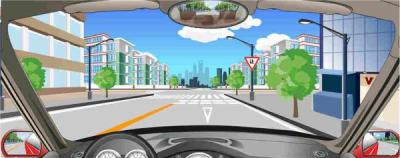1、Before setting off, it is necessary to check the driving cabin, engine cabin, external and tires of the motor vehicle.
A、Right
B、Wrong
Answer:A
2、How should lamps be used when motor vehicle drivers pass through a two-way tunnel?
A、Turn on the hazard lamps
B、Turn on the high-beam
C、Turn on the fog lamp
D、Turn on the low-beam
Answer:D
3、The sign on the right indicates a section for ascertaining the distance between the vehicles 200 meters ahead.

A、Right
B、Wrong
Answer:A
4、The slow-down-and-yield line at the intersection ahead indicates that vehicle drivers should stop and give the right of way to vehicles on the trunk road.

A、Right
B、Wrong
Answer:B
5、When driving onto the left lane, motor vehicle drivers are allowed to make a U-turn.

A、Right
B、Wrong
Answer:A
6、What should motor vehicle drivers do under the circumstance shown in the flash?

A、Drive by borrowing the opposite lane
B、Brake suddenly and pass through at a lower speed
C、Drive by the outer side of the curve
D、Reduce speed fully and drive by the right side
Answer:D
7、When a wounded person suffering burns is thirsty, he should only drink plain boiled water.
A、Right
B、Wrong
Answer:B
8、The sign above the tunnel indicates a height limit of 3.5 meters on the road ahead.

A、Right
B、Wrong
Answer:A
9、What is the function of ABS during emergency braking?
A、Shortening the braking distance
B、Keeping steering capacity of the motor vehicle
C、Relief the braking inertia
D、Controlling directions automatically
Answer:B
10、When a motor vehicle encounters an emergency on an expressway, the driver should not swiftly turn the steering wheel to evade.
A、Right
B、Wrong
Answer:A
11、What should the driver do when he/she encounters an oncoming ambulance in the same lane?
A、Keep to the side and reduce speed or stop to yield
B、Drive ahead by occupying another lane
C、Yield by speeding up and changing lanes
D、Drive ahead in the original lane
Answer:A
12、Which of the following measures should be taken first when rescuing a wounded person suffering blood loss?
A、Observe
B、Dress the wounds
C、Stop bleeding
D、Inquire
Answer:C
13、What's the meaning of the sign on the right?

A、Long-time parking permitted
B、Temporary parking permitted
C、Long waiting for passengers permitted
D、No parking
Answer:B
14、The sign on the right warns for livestock on the road ahead.

A、Right
B、Wrong
Answer:B
15、At 13: 10 pm, Mr Luo set out in his medium bus from 0 km mark on the highway, and by 14: 10 had passed the 125km mark by 200 meters, he caused a rear-end collision with a motor vehicle that ran into the side slope on the southwest side, killing 11 people and injuring 2. Which of the following law-breaking acts did Mr. Luo commit?
A、Speeding
B、Driving not in accordance with traffic markings
C、Exceeding carrying capacity
D、Fatigued driving
Answer:A
16、The sign on the right warns of a village 200 meters ahead.

A、Right
B、Wrong
Answer:A
17、Which one of the following is a safe way for motor vehicles to converge into an intersection marked with this sign?

A、Speeding up and driving into the traffic flow directly
B、Driving into the traffic flow behind the gray car on the main road
C、Driving into the traffic flow from the front of the red car on the main road
D、Turning on the indicator and driving into the flow directly
Answer:B
18、When the motor vehicle stops on a downhill section how should the driver use the foot brake?
A、Earlier than on a level road
B、Later than on a level road
C、As timely as on a level road
D、Gently depress the foot brake pedal
Answer:A
19、Which one of the following statements is correct in this situation?

A、Vehicles are prohibited from passing in the lanes on either side
B、Move into the lane on either side at a reduced speed
C、Move into the lane on the right side
D、Move into the lane on either side at an increased speed
Answer:A
20、The sign in front is an advance announcement of the directions led by the interchange.

A、Right
B、Wrong
Answer:A